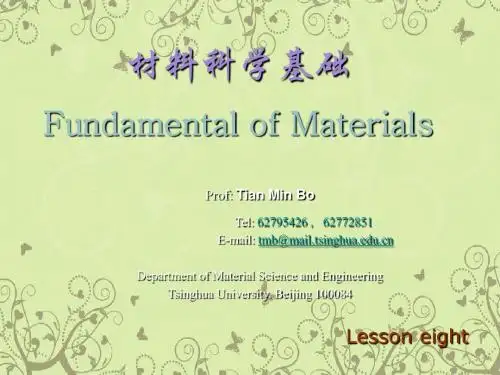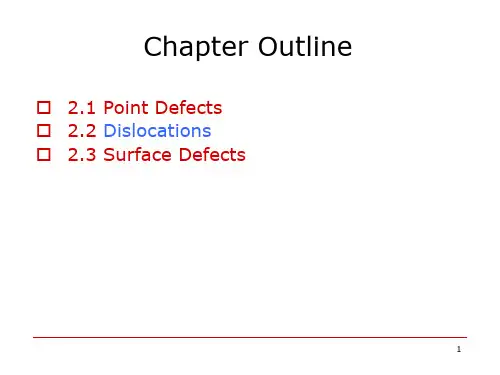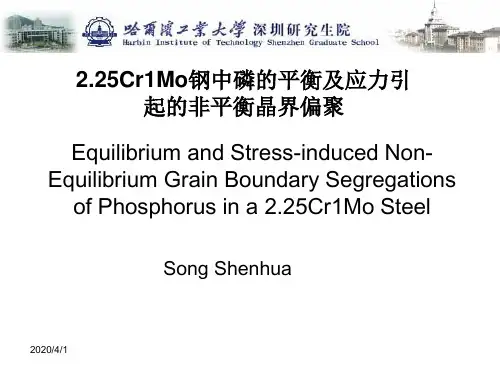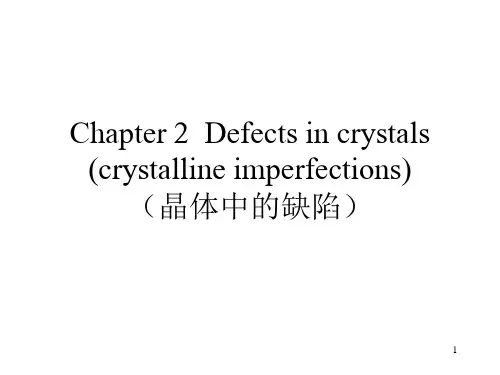2材料科学基础英文版课件_(8)
合集下载
材料科学基础_08PPT课件

0.85R0 R0 1.15R0 R
Dorken-Gurry graphic
4. Electron concentration factor, e/a e: the number of valence electrons a: the number of atoms e/a = average number of valence electrons per atom.
②
Structure vs. e/a
for CuZn alloy system α(CuZn) —— e/a = 3/2 = 21/14 β(Cu5Zn8)—— e/a = 21/13 γ(CuZn3) —— e/a = 7/4 = 21/12
1. What is size factor metallic radii rA+rB =d Atomic radii
ionic radii r++r - =d
covalent radii single bond radius
Van der Waals radii
CN
radii
BCC
FCC
3 CN of BCC:8( a )+6(a) 2 3 3 a = rα = 0.290nm 4 4 = 0.12557nm
EBB—— bonding energy between B-B atoms EAB—— bonding energy between A-B atoms
3. Electron concentration ( e/a ) Electron concentration ( e/a ) is the number of valence electrons per atom on the average. i.g. for CuZn : e/a = 3/2 =1.5
材料科学基础--第2章晶体缺陷PPT课件

辐照:在高能粒子的辐射下,金属晶体点阵上的原子 可能被击出,发生原子离位。由于离位原子的能量高, 在进入稳定间隙之前还会击出其他原子,从而形成大量 的间隙原子和空位(即弗兰克尔缺陷)。在高能粒子辐 照的情况下,由于形成大量的点缺陷,而会引起金属显 著硬化和脆化,该现象称为辐照硬化。
12
2.1.5点缺陷与材料行为
Or, there should be 2.00 – 1.9971 = 0.0029 vacancies per unit cell. The number of vacancies per cm3 is:
17
Other Point Defects
Interstitialcy - A point defect caused when a ‘‘normal’’ atom occupies an interstitial site in the crystal.
11
2.1.4 过饱和点缺陷
晶体中的点缺陷浓度可能高于平衡浓度,称为过饱和点 缺陷,或非平衡点缺陷。获得的方法:
高温淬火:将晶体加热到高温,然后迅速冷却(淬火 ),则高温时形成的空位来不及扩散消失,使晶体在低 温状态仍然保留高温状态的空位浓度,即过饱和空位。
冷加工:金属在室温下进行冷加工塑性变形也会产生 大量的过饱和空位,其原因是由于位错交割所形成的割 阶发生攀移。
6
2.1.1 分类
3.置换原子(Substitutional atom) 异类原子代换了原有晶体中的原子,而处于晶体点阵的结 点位置,称为置换原子,亦称代位原子。 各种点缺陷,都破坏了原有晶体的完整性。它们从电学
和力学这两个方面,使近邻原子失去了平衡。空位和直 径较小的置换原子,使周围原子向点缺陷的方向松弛, 间隙原子及直径较大的置换原子,把周围原子挤开一定 位置。因而在点缺陷的周围,就出现了一定范围的点阵 畸变区,或称弹性应变区。距点缺陷越远,其影响越小 。因而在每个点缺陷的周围,都会产生一个弹性应力场 。
12
2.1.5点缺陷与材料行为
Or, there should be 2.00 – 1.9971 = 0.0029 vacancies per unit cell. The number of vacancies per cm3 is:
17
Other Point Defects
Interstitialcy - A point defect caused when a ‘‘normal’’ atom occupies an interstitial site in the crystal.
11
2.1.4 过饱和点缺陷
晶体中的点缺陷浓度可能高于平衡浓度,称为过饱和点 缺陷,或非平衡点缺陷。获得的方法:
高温淬火:将晶体加热到高温,然后迅速冷却(淬火 ),则高温时形成的空位来不及扩散消失,使晶体在低 温状态仍然保留高温状态的空位浓度,即过饱和空位。
冷加工:金属在室温下进行冷加工塑性变形也会产生 大量的过饱和空位,其原因是由于位错交割所形成的割 阶发生攀移。
6
2.1.1 分类
3.置换原子(Substitutional atom) 异类原子代换了原有晶体中的原子,而处于晶体点阵的结 点位置,称为置换原子,亦称代位原子。 各种点缺陷,都破坏了原有晶体的完整性。它们从电学
和力学这两个方面,使近邻原子失去了平衡。空位和直 径较小的置换原子,使周围原子向点缺陷的方向松弛, 间隙原子及直径较大的置换原子,把周围原子挤开一定 位置。因而在点缺陷的周围,就出现了一定范围的点阵 畸变区,或称弹性应变区。距点缺陷越远,其影响越小 。因而在每个点缺陷的周围,都会产生一个弹性应力场 。
最新2材料科学基础英文版课件_(10)

External Surfaces
• Surface atoms are not bonded to the nearest neighbors above the surface, leading to a higher energy state, i.e., a surface energy
• To be stable, materials need to reduce the surface energy.
Edge dislocation
Screw dislocation
Mixed dislocation
• Effects of dislocations on the properties of materials
–ormation of materials
Tilt boundary
Twist boundary
Use to represent the extent of CSL e.g., 3, 15, etc.
CSL boundary (coincidence site lattice boundary) Special boundary
Grain boundary segregation
• Observation of dislocations
Dark lines - dislocations
Plane Defects
Features: two dimensional
Outline
• External surfaces • Grain boundaries • Twin boundaries • Stacking faults • Phase boundaries
– Dislocation strengthening is one of the major strengthening mechanisms for metallic materials
20172材料科学基础英文版

Segregation kinetics
C t C 0 Ceq C 0
1
exp
4Dt
2 2
d
2
erfc
4Dt
22d 2
2 Ceq Cg
erfc(x) = 1 – erf(x)
2020/4/1
(McLean, 1957)
Equilibrium grain boundary segregation (3)
e.g., in structural materials, such as steel and Ni alloys Segregation of detrimental elements such as S, P, Sn, and Sb – decreasing the grain boundary cohesion – grain boundary weakening Segregation of beneficial elements such as B, C and Be – increasing the grain boundary cohesion – grain boundary strenthening
Gi
RT ,
i I, M
GI GI0 IM CMeq CMg
(Guttmann, 1975)
GM GM0 IM CIg
exp
Gi
RT ,
i I, M
2020/4/1
(Seah, 1977)
Equilibrium grain boundary segregation (2)
• Stress-induced non-equilibrium grain boundary
segregation – Introduction, experiment, results and discussion,
材料科学基础(英)2

点缺陷与线缺陷和面缺陷的一个主要区别在于点缺陷是 一种热力学稳定的缺陷,在晶体中,点缺陷始终处于不 断产生和消失的过程中,最终达到一个稳定的平衡值, 此时晶体中点缺陷数目不变,可以通过统计热力学的方 法进行计算。 两种点缺陷中,空位具有比较小的畸变能。 10
At equilibrium, the fraction of lattice that is vacant at a given temperature (T) is given approximately by the equation: n where n is the number of vacant sites in N sites and Es is the energy required to move an atom from the interior of a crystal to its surface. k is Boltzmann’s constant and equal to 1.380*10-23JK-1. Additional vacancies in metals can be introduced by plastic deformation, rapid cooling, and bombardment with energetic particles such as neutrons.
15
C04CATER.MOV
16
• 1934 年,Taylor 、Orowan 和Polanyi 几乎同时分 别独立地提出了位错模型,认为晶体存在有一种 线缺陷—刃型位错,它在切应力下容易滑移,并 可引起范性形变。其中以Taylor 的工作最为深 入,他把位错与晶体塑性时的滑移过程联系起来 。滑移时,晶体的上半部相对于下半部不是同时 作整体刚性的移动,而是通过位错在切应力作用 下于晶体中逐步地移动来进行。当位错由晶体 的一端移到另一端时,只需其邻近原子作很小距 离的弹性偏离就可能实现,而晶体中其它区域的 原子仍处于正常位置,因而滑移时所需的切应力 大为减少。
At equilibrium, the fraction of lattice that is vacant at a given temperature (T) is given approximately by the equation: n where n is the number of vacant sites in N sites and Es is the energy required to move an atom from the interior of a crystal to its surface. k is Boltzmann’s constant and equal to 1.380*10-23JK-1. Additional vacancies in metals can be introduced by plastic deformation, rapid cooling, and bombardment with energetic particles such as neutrons.
15
C04CATER.MOV
16
• 1934 年,Taylor 、Orowan 和Polanyi 几乎同时分 别独立地提出了位错模型,认为晶体存在有一种 线缺陷—刃型位错,它在切应力下容易滑移,并 可引起范性形变。其中以Taylor 的工作最为深 入,他把位错与晶体塑性时的滑移过程联系起来 。滑移时,晶体的上半部相对于下半部不是同时 作整体刚性的移动,而是通过位错在切应力作用 下于晶体中逐步地移动来进行。当位错由晶体 的一端移到另一端时,只需其邻近原子作很小距 离的弹性偏离就可能实现,而晶体中其它区域的 原子仍处于正常位置,因而滑移时所需的切应力 大为减少。
材料科学与工程专业英语课件

• These alloy additions are chosen carefully because they invariably bring with them sharply increased material costs. They are justified only by essential improvements in properties such as higher strength or improved corrosion resistance
1.1.1 Iron and Steel
The iron ore which we find on earth is not pure. It contains some impurities that must be removed by smelting. The process of smelting consists of heating the ore in a blast furnace with coke and limestone, and reducing it to metal. Blasts of hot air enter the furnace from the bottom and provide the oxygen that is necessary for the reduction of the ore.
1.1.1 Iron and Steel
• We can melt this down again in another furnace-a cupola-with more coke and limestone, and tap it out into a ladle or directly into molds. This is cast iron. Cast iron does not have the strength of steel. It is brittle and may fracture under tension.
1.1.1 Iron and Steel
The iron ore which we find on earth is not pure. It contains some impurities that must be removed by smelting. The process of smelting consists of heating the ore in a blast furnace with coke and limestone, and reducing it to metal. Blasts of hot air enter the furnace from the bottom and provide the oxygen that is necessary for the reduction of the ore.
1.1.1 Iron and Steel
• We can melt this down again in another furnace-a cupola-with more coke and limestone, and tap it out into a ladle or directly into molds. This is cast iron. Cast iron does not have the strength of steel. It is brittle and may fracture under tension.
材料科学基础双语课件
control the material properties (for example by altering the
grain structure, or the presence of defects in the atom
packing) or to fabricate the material into the desired shape.
extra material, joining parts (e.g., by soldering or welding),
forming (forging, rolling, bending, etc.), or compacting particles which are then fused together (sintering, used for
gases (and most engineering materials are used in solid
form).
1.1 What is Materials Science and Engineering?
It may seem abstract and remote from real engineering to
The Science and Engineering of Materials
Aim
English atmosphere: speaking, reading, writing and lisห้องสมุดไป่ตู้ening; Specialty vocabulary; Specialty knowledge;
form. As this mixture solidifies, different structures form as a function of temperature. The phase diagrams that provide
grain structure, or the presence of defects in the atom
packing) or to fabricate the material into the desired shape.
extra material, joining parts (e.g., by soldering or welding),
forming (forging, rolling, bending, etc.), or compacting particles which are then fused together (sintering, used for
gases (and most engineering materials are used in solid
form).
1.1 What is Materials Science and Engineering?
It may seem abstract and remote from real engineering to
The Science and Engineering of Materials
Aim
English atmosphere: speaking, reading, writing and lisห้องสมุดไป่ตู้ening; Specialty vocabulary; Specialty knowledge;
form. As this mixture solidifies, different structures form as a function of temperature. The phase diagrams that provide
材料科学基础英文版课件(PDF)
Law • Steady State: the concentration profile doesn't
change with time.
Steady State:
J x(left)
J x(right) J x(left) = J x(right)
x
Concentration, C, in the box doesn’t change w/time.
Non Steady State Diffusion
• Concentration profile,
dx
C(x), changes with time. J (left)
J (right)
• To conserve matter:
J (right)
− J (left)
=
dC −
dx
dt
dJ = − dC
ΔJ y
=
− ∂J y ∂y
dxdydzδt
ΔJ z
= − ∂J z ∂z
dxdydzδt
对整个元体积:
−
⎜⎜⎝⎛
∂J x ∂x
+
∂J y ∂y
+
∂J z ∂z
⎟⎟⎠⎞dxdydzδt
若 δt 时间内粒子浓度变化δc ,则在dxdydz
元体积中粒子变化为
δcdxdydz
∴ ∂c ∂t
=
−⎜⎜⎝⎛
∂J x ∂x
Fick’s Second Law
δt 时间内沿x方向扩散
元体积dxdydz
流入的粒子数: J x dydzδt
流出的粒子数:
(J x
+
∂J x ∂x
dx)dydzδt
skja_06CrystallographicFormulas材料科学基础英文课件
(u1a)2 (v1b)2 (w1c)2 (u2a)2 (v2b)2 (w2c)2
For hexagonal: cos
u1u2
v1v2
w1w2
(
c a
)2
1 2
(u1v2
u2v1)
u12
v12
w12
(
c a
)2
u1v1
u22
v22
w22
(
c a
)2
u2v2
10. The volume of unit cells V
材料科学基础
Fundamental of Materials
Prof: Tian Min Bo
Tel: 62795426 ,62772851 E-mail: tmb@ Department of Material Science and Engineering Tsinghua University. Beijing 100084
For hexagonal crystals:
1 d2
4 3
h2
hk a2
k2
l2 c2
7. The length of [u v w]
L[uvw] (ua )2 (vb )2 (wc )2 2vwbccos 2uwac cos 2uvabcos
For cubic: L[uvw] a u2 v2 w2
For simple cubic (001) aaaa…… (110) abab……
shift 1 [1 10], along [1 10] 2
This sequence is called the stacking order
Ⅱ.Comparison of stacking mode of HCP and FCC
【大学】材料科学基础(中英版)
Materials in first industrial revolution (1881-1935). Materials in second industrial revolution (1935-1980). Materials today – too,ooo,ooo… many (1980- ).
第21页
Materials science and engineering
The relationship between materials science and materials engineering
Materials science Why it has…
Materials engineering How to make…
Time: Location: Activities:
Present new study material Announce reading and homework Take quizzes
第4页
授课信息
授课人: 时间: 地点: 主要活动:
教授新课 布置作业 课堂测验
第5页
Recitations
第1Байду номын сангаас页
What is material?
Classifications of materials
Based on the chemical composition: Metals, Non-metal inorganic materials (ceramic mateials) Polymers, Composites
Materials, energy and information are the three pillars of current human civilization.
第21页
Materials science and engineering
The relationship between materials science and materials engineering
Materials science Why it has…
Materials engineering How to make…
Time: Location: Activities:
Present new study material Announce reading and homework Take quizzes
第4页
授课信息
授课人: 时间: 地点: 主要活动:
教授新课 布置作业 课堂测验
第5页
Recitations
第1Байду номын сангаас页
What is material?
Classifications of materials
Based on the chemical composition: Metals, Non-metal inorganic materials (ceramic mateials) Polymers, Composites
Materials, energy and information are the three pillars of current human civilization.
- 1、下载文档前请自行甄别文档内容的完整性,平台不提供额外的编辑、内容补充、找答案等附加服务。
- 2、"仅部分预览"的文档,不可在线预览部分如存在完整性等问题,可反馈申请退款(可完整预览的文档不适用该条件!)。
- 3、如文档侵犯您的权益,请联系客服反馈,我们会尽快为您处理(人工客服工作时间:9:00-18:30)。
1) Composites
Composed of more than one material type – one: matrix; other(s): reinforcing addition
Matrix – polymeric, metallic, or ceramic materials
Reinforcing addition: glass fibers, carbon fibers, ceramic fibers (e.g. basalt fibers) or nanoparticles (e.g. SiC, SiN, etc)
To modify existing materials and develop new materials, we need to know MSE
Classification of materials
In terms of chemical makeup and atomic structure Metals; Ceramics; Polymers
2材料科学基础英文版课件_(8)
Assessment Structure
• Written examination (50%) • Oral presentation (20%, any topics in
Chapter 7 – Mechanical Properties, 4 students as a group, 15 minutes) • Report (20%, any topics in materials science and engineering) • Assignment (10%)
What is materials science and engineering
• Materials science Concerned with the relationship between
composition, structure and properties of materials • Materials engineering
3) Polymeric: organic compounds based on carbon, hydrogen and other nonmetallic elements – plastics and rubbers Normally low density and relatively flexible
Concerned with designing or engineering the structure to produce a predetermined set of properties
The structure of a material depends on what composition it has and how it is processed. Also, the performance of a material is a function of its properties • MSE: Composition-processing-structureproperties-performance relationship
Designed to display a combination of the best properties of each of the components
2) Semiconductors
Electrical properties being intermediate between conductors and insulators and being very sensitive to their composition and environmental conditions (e.g., functional ceramics: microwave dielectric ceramics, ferroelectric and piezoelectric ceramics)
2) Ceramic: compounds between metallic and nonmetallic elements – oxides, nitrides, and carbides Very insulative to electricity and heat – very low electrical and thermal conductivities Highly resistant to high temperatures and corrosive environments Very hard but very brittle
Additional types of material
Composites; Semiconductors; and Biomaterials
They originate from the three basics (metals, ceramics and polymers), but they have special us study materials science and engineering
All applied scientists and engineers in any engineering areas: design problems involving materials
To select a right material from many thousands according to service conditions and property requirements, we need to have the knowledge of MSE
1) Metallic: combinations of metallic elements Free electrons – good electrical and thermal conductivities Strong but deformable – extensive use in structural applications
Composed of more than one material type – one: matrix; other(s): reinforcing addition
Matrix – polymeric, metallic, or ceramic materials
Reinforcing addition: glass fibers, carbon fibers, ceramic fibers (e.g. basalt fibers) or nanoparticles (e.g. SiC, SiN, etc)
To modify existing materials and develop new materials, we need to know MSE
Classification of materials
In terms of chemical makeup and atomic structure Metals; Ceramics; Polymers
2材料科学基础英文版课件_(8)
Assessment Structure
• Written examination (50%) • Oral presentation (20%, any topics in
Chapter 7 – Mechanical Properties, 4 students as a group, 15 minutes) • Report (20%, any topics in materials science and engineering) • Assignment (10%)
What is materials science and engineering
• Materials science Concerned with the relationship between
composition, structure and properties of materials • Materials engineering
3) Polymeric: organic compounds based on carbon, hydrogen and other nonmetallic elements – plastics and rubbers Normally low density and relatively flexible
Concerned with designing or engineering the structure to produce a predetermined set of properties
The structure of a material depends on what composition it has and how it is processed. Also, the performance of a material is a function of its properties • MSE: Composition-processing-structureproperties-performance relationship
Designed to display a combination of the best properties of each of the components
2) Semiconductors
Electrical properties being intermediate between conductors and insulators and being very sensitive to their composition and environmental conditions (e.g., functional ceramics: microwave dielectric ceramics, ferroelectric and piezoelectric ceramics)
2) Ceramic: compounds between metallic and nonmetallic elements – oxides, nitrides, and carbides Very insulative to electricity and heat – very low electrical and thermal conductivities Highly resistant to high temperatures and corrosive environments Very hard but very brittle
Additional types of material
Composites; Semiconductors; and Biomaterials
They originate from the three basics (metals, ceramics and polymers), but they have special us study materials science and engineering
All applied scientists and engineers in any engineering areas: design problems involving materials
To select a right material from many thousands according to service conditions and property requirements, we need to have the knowledge of MSE
1) Metallic: combinations of metallic elements Free electrons – good electrical and thermal conductivities Strong but deformable – extensive use in structural applications
